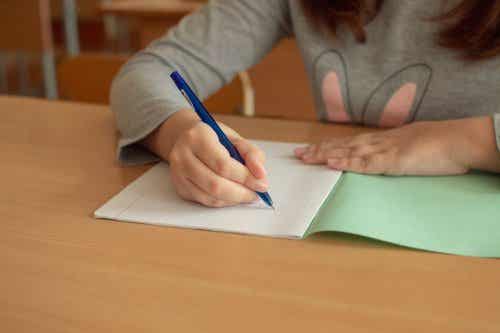Help Your Child to Understand and Learn Effectively

In this article, we’re going to share some steps to help your child understand and learn effectively. These steps will help them work on their comprehensive memory. Then, they’ll have an easier time retaining and expressing the information, and it’ll be harder to forget what they’ve learned.
Help your child understand and learn effectively
To help your child understand a written text better, you can use the following strategies:
Skim the text
First, quickly read over the text so you can get a general idea of what it’s about. In addition, it’s important to read the title of the text because it’ll help you understand it better. Also, you’ll be able to take in information right from the start.
Comprehensive reading of each paragraph
Then, your child should carefully read each paragraph in the text. That way, they’ll be able to extract the main idea from each paragraph. To do this, they should ask themselves: “What is this paragraph talking about?” And, “What does it say?” If they didn’t understand it correctly the first time, they should read it as many times in order to fully understand it.

Next, they should put a title next to each paragraph. This title should reflect the main idea or theme of the paragraph. Also, you should keep in mind that these titles don’t need to be a summary, so one or two words is enough. To help with this process, your child can underline any keywords that reflect the main idea.
Understand the text’s organization
The next step is to understand the organization within the text. It’s important to know that all texts have some form of organization. And, you can organize this structure and look at it graphically. There are five basic ways to organize the information in a text:
- Comparison. The text compares two or more things or phenomena. For example, the text is comparing temperate weather to warm weather. When talking about each type of weather, the writer will talk about each of their characteristics. If your child is having trouble, you can encourage them to ask themselves what the differences and similarities are between the two things.
- Problem and solution. In this type of organization, one part of the text discusses a problem and other part discusses solutions. For example, when writers write about poverty in the world and how to avoid that problem. Sometimes, they may provide more than one solution, which means it’s a good idea to separate each of the solutions when organizing.
- Causality. Texts about causality relate two or more phenomena in terms of one thing causing the other. For example, “Polluting the environment is the main cause of global warming.” In these texts, they’ll mention one thing that may cause one or more other things. In addition, they may mention several other factors responsible for other phenomenon (causes).
- Description. As the name implies this type of text describes an event, a fact, a character, etc. To make this graphic organizer, it’s best to separate the different things that are being described. For example, if the text is telling us about a country, you can differentiate its geography, its economy, its culture, etc.
- Sequence. This type of text describes the steps or phases of an event over time. For example, the text may describe how volcanoes were formed. Then, you can use the diagram to organize all of the phases separately.
More steps to help your child understand and learn effectively
Figure out the text’s organization
Once you know how the writer organized the text, you have to figure out which paragraphs contain the basic components of the text’s structure. That way, if you’re reading a text with problem and solution organization, for example, you can locate both the problem and the solution.
Make the text outline
After figuring out the text’s organization, you can make the text outline. An outline will help your child organize the information they’ve read in the text. This graphic organizer will help them understand the text’s organization and its components. In order to make the outline, your child should ask themselves the following questions:

- What kind of graphic organizer will be best for this type of organization?
- How many different components will I need to organize my ideas?
For example, if the text has a causal organization, your child should ask themselves: “What are the effects and what are the causes?”
Create a text summary
In the previous phase, we made a graphic organizer to better comprehend the text. Now, we’re going to add some of our own words about the text. To do this, your child should write a good summary that includes the main ideas and the most relevant information. The main idea should stand out from any secondary ideas. Also, they should keep in mind that a good summary must:
- Be short and precise.
- Express the main ideas of the text in your own words. In addition, it should always be done in an organized way, with continuity and coherence.
- Skip any information that’s not important to know and isn’t necessary to understanding the text.
- Replace some information with more general concepts or more specific ideas.
- Start with the information you already know and add to it with new information. That way, you’ll be increasing your current knowledge.
Ask questions about the text, the last step to help your child understand and learn effectively
Lastly, your child should ask themselves questions about the text. For example, “What might a teacher ask us on a test or in a class discussion about this text?” Or, “If I were a teacher, what would I ask my students?”
Conclusion
If you can get your children to follow these steps when they’re studying, they’ll be able to increase their understanding. As a result, they’ll have an easier time remembering what they’ve read, and expressing it both orally and in writing. Therefore, their learning will be more meaningful, easier to remember and they’ll be able to express themselves in any situation.
In this article, we’re going to share some steps to help your child understand and learn effectively. These steps will help them work on their comprehensive memory. Then, they’ll have an easier time retaining and expressing the information, and it’ll be harder to forget what they’ve learned.
Help your child understand and learn effectively
To help your child understand a written text better, you can use the following strategies:
Skim the text
First, quickly read over the text so you can get a general idea of what it’s about. In addition, it’s important to read the title of the text because it’ll help you understand it better. Also, you’ll be able to take in information right from the start.
Comprehensive reading of each paragraph
Then, your child should carefully read each paragraph in the text. That way, they’ll be able to extract the main idea from each paragraph. To do this, they should ask themselves: “What is this paragraph talking about?” And, “What does it say?” If they didn’t understand it correctly the first time, they should read it as many times in order to fully understand it.

Next, they should put a title next to each paragraph. This title should reflect the main idea or theme of the paragraph. Also, you should keep in mind that these titles don’t need to be a summary, so one or two words is enough. To help with this process, your child can underline any keywords that reflect the main idea.
Understand the text’s organization
The next step is to understand the organization within the text. It’s important to know that all texts have some form of organization. And, you can organize this structure and look at it graphically. There are five basic ways to organize the information in a text:
- Comparison. The text compares two or more things or phenomena. For example, the text is comparing temperate weather to warm weather. When talking about each type of weather, the writer will talk about each of their characteristics. If your child is having trouble, you can encourage them to ask themselves what the differences and similarities are between the two things.
- Problem and solution. In this type of organization, one part of the text discusses a problem and other part discusses solutions. For example, when writers write about poverty in the world and how to avoid that problem. Sometimes, they may provide more than one solution, which means it’s a good idea to separate each of the solutions when organizing.
- Causality. Texts about causality relate two or more phenomena in terms of one thing causing the other. For example, “Polluting the environment is the main cause of global warming.” In these texts, they’ll mention one thing that may cause one or more other things. In addition, they may mention several other factors responsible for other phenomenon (causes).
- Description. As the name implies this type of text describes an event, a fact, a character, etc. To make this graphic organizer, it’s best to separate the different things that are being described. For example, if the text is telling us about a country, you can differentiate its geography, its economy, its culture, etc.
- Sequence. This type of text describes the steps or phases of an event over time. For example, the text may describe how volcanoes were formed. Then, you can use the diagram to organize all of the phases separately.
More steps to help your child understand and learn effectively
Figure out the text’s organization
Once you know how the writer organized the text, you have to figure out which paragraphs contain the basic components of the text’s structure. That way, if you’re reading a text with problem and solution organization, for example, you can locate both the problem and the solution.
Make the text outline
After figuring out the text’s organization, you can make the text outline. An outline will help your child organize the information they’ve read in the text. This graphic organizer will help them understand the text’s organization and its components. In order to make the outline, your child should ask themselves the following questions:

- What kind of graphic organizer will be best for this type of organization?
- How many different components will I need to organize my ideas?
For example, if the text has a causal organization, your child should ask themselves: “What are the effects and what are the causes?”
Create a text summary
In the previous phase, we made a graphic organizer to better comprehend the text. Now, we’re going to add some of our own words about the text. To do this, your child should write a good summary that includes the main ideas and the most relevant information. The main idea should stand out from any secondary ideas. Also, they should keep in mind that a good summary must:
- Be short and precise.
- Express the main ideas of the text in your own words. In addition, it should always be done in an organized way, with continuity and coherence.
- Skip any information that’s not important to know and isn’t necessary to understanding the text.
- Replace some information with more general concepts or more specific ideas.
- Start with the information you already know and add to it with new information. That way, you’ll be increasing your current knowledge.
Ask questions about the text, the last step to help your child understand and learn effectively
Lastly, your child should ask themselves questions about the text. For example, “What might a teacher ask us on a test or in a class discussion about this text?” Or, “If I were a teacher, what would I ask my students?”
Conclusion
If you can get your children to follow these steps when they’re studying, they’ll be able to increase their understanding. As a result, they’ll have an easier time remembering what they’ve read, and expressing it both orally and in writing. Therefore, their learning will be more meaningful, easier to remember and they’ll be able to express themselves in any situation.
This text is provided for informational purposes only and does not replace consultation with a professional. If in doubt, consult your specialist.








